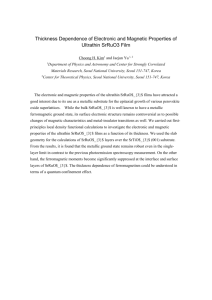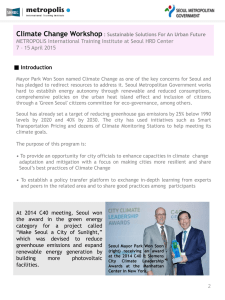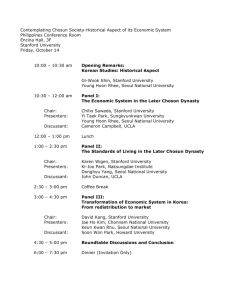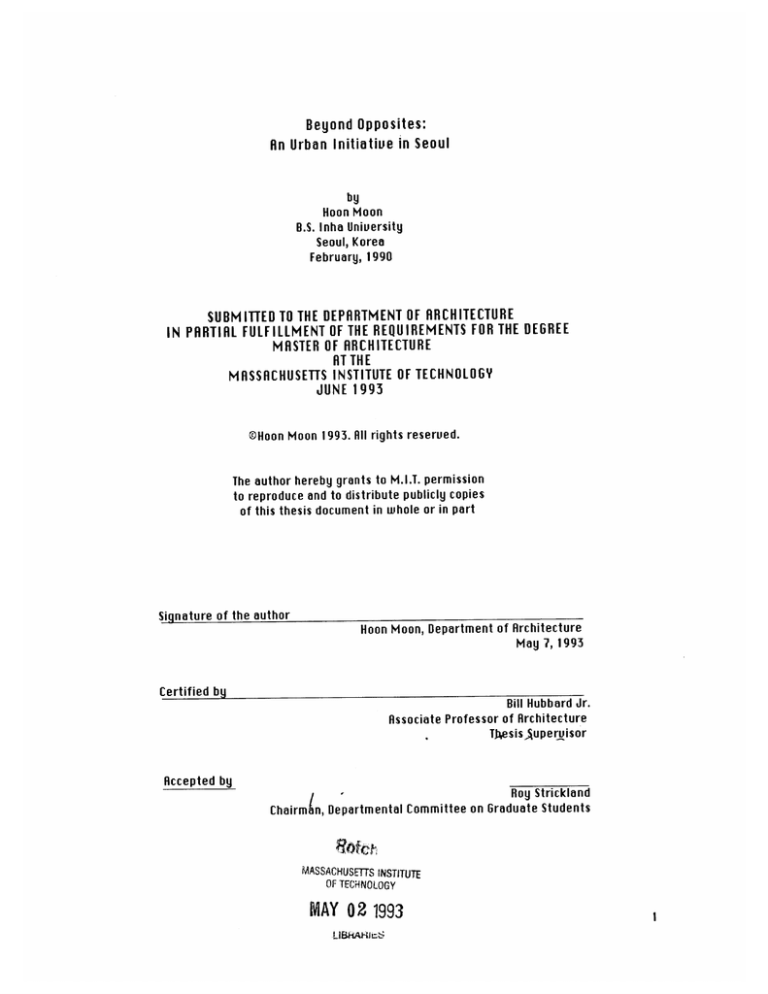
Beyond Opposites:
fin Urban Initiative in Seoul
by
Hoon Moon
B.S. Inha University
Seoul, Korea
February, 1990
SUBMITTED TO THE DEPARTMENT OF ARCHITECTURE
IN PARTIAL FULFILLMENT OF THE REQUIREMENTS FOR THE DEGREE
MASTER OF ARCHITECTURE
AT THE
MASSACHUSETTS INSTITUTE OF TECHNOLOGY
JUNE 1993
®Hoon Moon 1993. All rights reserved.
The author hereby grants to M.I.T. permission
to reproduce and to distribute publicly copies
of this thesis document in whole or in part
Signature of the author
Hoon Moon, Department of Architecture
May 7, 1993
Certified by
Accepted by
Bill Hubbard Jr.
Associate Professor of Architecture
Th4esisjuperisor
Roy Strickland
Students
Graduate
on
Chairmn, Departmental Committee
MASSACHUSETTS INSTITUTE
OF TECHNOLOGY
MAY 02 1993
LIBHAFti:S
?
cknowledgment
To People who have helped me by their silent eHistence.
4
Beyond Opposites:
An Urban initiative in Seoul
by
Hoon Moon
Submitted to the Department of Architecture on May 7, 1993
In partial fulfillment of the requirements for the Degree of
Master of Architecture
ABSTRA RCT
The thesis began with the understanding of urban, cultural, and social
conditions of Seoul. The choice of the existing bridge as the point of
departure has meaning in two layers.
Layer one: the need for more space in the city of Seoul has initiated
intense discussions on alternative building sites-underground cities.
The choice of the bridge was made as yet another possible alternative.
Layer two: Seoul, like any other city, is full of urban attempts and failures.
These mistakes and scars are taken as a point of departure, not as a
point of destruction and restart. These structures have become our
second nature, man-made nature. The existing bridge is one of the
possible place for a new beginning.
The program layers for the thesis began on the basis of disparitiesharmonies, and , chaos-order imbedded in Seoul.
Layer one: The need for 24 hour zone to accommodate various life styles
in the megacity(not a single district is open for 24 hours).
The need for a place where disappearing values, traditions, and
rituals can be practiced(religious and performance facility).
Layer two: The need for exemplification and accentuation of what is,
so that we become aware.
The need for a place of exposure and awareness, where implicit but
wide spread practices become explicit.
Thesis Supervisor: Bill Hubbard Jr.
Title: Associate Professor of Architecture
6
Table of Contents
mong
s a n g:
n i:
m o n g s a n g n i:
10 SEOUL
12 SEOUL images
14 The Larger Site
16 The Site: Dongho Bridge
18 The River
24 Roots
25 Notes on Thesis
26 Program: Layers
28 Program
30 Design Initiative: Layer One
32 Design Initiative: Layer Two
36 Sketches
60 Final Presentation
77 Bibliography
All drawings, Illustrations, sketches, and Photographs contained in this thesis is done by
the author, unless otherwise noted.
Picture Credits.
fig. 1, and 2: 4.3 group, ECHOES OF AN ERA, Ahn Graphics, 1992.
fig. 3, 4, 5, 6, 7, 8, and 9: Jin-Re, Kim, SEOUL INESS, Seoul Forum, 1991.
fig. 10: Yun-Shik, Hong/ Yeol-Soo, Yun, BUDDHIST PAINTING, Daewonsa, 1991.
PLAYBOY, January 1993.
mn
fig. 1
. ....
new
fancy
shock
ephemeral
karaoke rooms
cafe
disco
loue hotel
Lotte world
fortune teller
shamanism
superficiality
discipline
churches
McDonald
Seuen Eleuen
KFC
uending machines
parking tower
market
palaces
tradition
no ualues
fashion
uogue
cool
images
Hyundai
Orange
Sonata
eHtravagance
show off
Tico
ryokwan
ero
RPT
Marzo
rush hour
Chanel
Gucci
Christianity
Buddhism
animism
Apkujungdong
daldongnae
Jung! jung!
Sony
Canon
Casio
Saga
Nonno
Illusion
hypocrisy
religious aspiration
W)
CM
E
SEOUL: Rn Overview
Seoul is a city of chaotic confusion that embodies the scars of
the past and potential healing in the future.
It was founded almost 600 years ago as the capital city for Vi
dynasty of Choseon. The fung-shi and gin-gang principles were
decisive and important factors for the birth of Seoul.
The city has two major anis, one of uisual continuity(northsouth alis of mountain range), and the other of separation
(east-west alis of the Han river).
fig. 4
Seoul is a dynamic breeding ground for the new on the basis of
its traditions-hidden treasures.
The extremely old and the extremelg new liues side by side, each
speaking for each era. The word 'context' has little meaning in
Seoul, since the rate of changes in density and form is so rapid.
In the 90s, there has been active discussions on the future of
Seoul. The expansion, density, and land prices in Seoul haue
reached its limit. Alternatiue possibilities, such as development
of under-ground cities, haue been announced. There is also
much debate on providing Seoul with a landmark of some sort
that would represent the caring intentions for the future of
Seoul in symbolic terms.
Seoul 1910
fig. 5
Seoul 1990
fig.6
fig.7
ii
The Larger Site
fig. 8
For the last 40 years or so, when Korea had only a singular
objectiue-economic growth, Seoul had to go through an
ordeal of expansion and incision without rest.
For eHample, there were much unbalanced development
of north and south of Seoul that resulted the notion of two
disparate cities of one that is much more privileged(souththe new city) over the other(north-the old city).
There is also the topological difference between the north
and the south. The north eHpanded on its own accord. The
whole organization of the city is rather organic, adapting
to contours and curues of the hills . On the other hand
the south is dominated by wide imposed grid.
The case is most extremely comprehensible around the
landings of the Dongho bridge.
fig. 9
The Site: Dongho bridge
Dongho bridge is mostly a vehicular connector
between north and south Seoul. There is also
a subway transit system and a station on it.
The eHposed concrete bays of the bridge is a
hidden beauty of intense power that can
momentarily bring about a solemn silence.
It might be such a short moment, but it will
be powerful enough to provide a refreshing
outlook and meaning to a city life of eHtreme
chaos and confusion.
-1 - - ---
"INAVI
/cm
/
.- -- mmm
The River
During the mid 80s, there was a greater
awareness of what Seoul, especially the
Han riuer could provide, and subsequently
large parks of sports and recreational
facilities were built along the two banks
of the river.
The interventions are not of a great
beauty , but it has provided some relief
and a place to visit in otherwise a very
tense and crowded city.
The Han riuer is slowly regaining the
richness it once had. It is becoming a
place where people can momentarily
detach themselues from the harsh
realities without negating their being
in the city.
-A
an
Roots
The hidden, unmanifest sustains the visible, manifest.
QUOTES
From delusion lead me to Truth.
From darkness lead me to Light.
From death lead me to immortality. I. 3. 28
Brihad-Aranyaka Upanishad
The invisible and subtle essence is the Spirit of the whole
universe. That is Reality. That is Truth. THOU ART THAT.
Chandogya Upanishad
Just as by knowing a piece of gold all that is gold can
be known, since any differences are only words and the
reality is only gold;
Chandogya Upanishad
When we return to the root , we gain the meaning;
When we pursue eHternal objects we lose the reason.
The moment we are enlightened within,
We go beyond the voidness of a world confronting us.
Seng-Ts'an
Abide not with dualism,
Carefully avoid pursuing it;
As soon as you have right and wrong,
Confusion ensues, and Mind is lost.
Seng-Ts'an
The object is an object for the subject,
The subject is a subject for the object;
Know that the relativity of the two
Rests ultimately on one emptiness.
Seng-Ts'an
Notes on Thesis
Beginning
The cities are full of urban attempts and failures.
These mistakes and scars are taken as a point of departure,
not as a point of destruction and restart. These structures have
become our second nature, man-made nature.
Summary
What eHists beforehand can be both a clue and a restriction.
The act of superimposing a new order over the old creates complexities
of adjustment and conflict. The large bed of the river embodies
innumerable matter of every health and harm. The intervention will
focus on the control of harm as the departure point and an ephemeral
tower as the inevitable destination.
Methodology
The theme of inhabiting eHisting structures or buildings have been my
primary inspiration for quite for some time.
One conflict will be the eHperiment of overlaying a new order over an old one.
Another conflict will be the crossing of two axis, one natural and the
other will.
The conflicts and harmonies created by these lines and superimpositions
will then be developed to bring about a synthesis.
Objective
Cacophony and Harmony: The objective would be that of understanding
chaos and order as one.-Chaos has order within, and Order has chaos within.
The eHisting structure will be the womb for the new intervention
while the intervention will be the guide for the rediscovery
of the existing structure.
Program: Layers
The visible city is often chaotic, dynamic, and ephemeral.
Power, money, and sex dominate it.
They last as long as their inter-dependency lasts.
It is indeed ephemeral.
The implicit eHistence of traditional values and religious
aspirations sustains the visible city in solemn silence.
The new, the fancy dominates the consciousness of Seoul.
The Karaoke rooms are a phenomenon. There were only a
few in Seoul three years ago. Now, They are everywhere.
It will wither as time goes on, and something else will
dominate.
Vending machines are everywhere.
Mechanical tower parking structures are everywhere.
We are not afraid of steel.
We are not afraid of technology.
The concept of the program began on the basis of
disparities-harmonies, and, chaos-order imbedded in Seoul.
The topological difference between north and south.
The visible us. hidden
The underprivileged us. The privileged.
The materialistic orientation us. Religious dependency.
The superficial following of Confucian traditions and values
vs. Degradation of our widespread religious roots-shamanism,
fortune telling, and etc.
The new us. Old
The program endeavors to express the needs for both the
spiritual, and the physical.
Layer one (euplicit need)
The need for 24 hour zone to accommodate various life styles
in the megacity(not a single district is open for 24 hours,
The influH of chain stores such as seven eleven is generating
and accommodating to various life styles).
Layer two (implicit need)
The need for exemplification and accentuation of what is, so
that we become aware.
The need for a place of exposure and awareness, where
implicit but widespread practices become eHplicit.
J~N
p
esa~a
Program
24 HOUR ZONE:(all equipped with automatic vending menu systems)
24 hour RMENITIES: Disco club
Kiosks
Cinema
Fortune teller cell
Meditation cell
Vertigo walkway
Seven Eleven
KFC
McDonald
[R game cell
Cafe
Pizza Hut
VRFTEL: (Virtual Reality Fantasy Hotel)
menu lobby
cell type 001-lodging capsules
cell type OOH-infinite menu URcells
THING: (controls 24hr zone; image data bank-no access)
Thing itself is an image projector
Thing can be experienced only through cell type OOH of VRFtel
RELIGIOUS ZONE:
Performance plaza(religious rituals and performances)
Crematorium(ash dispatching platforms)
Lookout platforms
Walkway
Filtering facility
PLRZR ZONE:
Barren plaza
Recycling plant
-t
24 HOUR ZONE
rMa
24 1r amenity
ine transport Terminal
-
-
24hr amenity
PL A Af Recycling Plant
rfteI
Th ng
-LIPLA
A2NE
eligious and Performanc a Faci ity
Filte ring Facility
A1,
r<Or
RELIGIOUS 2ONE
k
29
Design Initiative: Lager One
There are 19 bridges in Seoul, but none of them is pedestrian oriented.
The first initial step of the design begins with the intention of providing
walkways.
One starts from the northern end of the bridge where a subway
station sits. The other begins from the southern riverbank plaza.
The walkway north is fragmented with the intention of reflecting the
contours, curves, and its organic organization of the north. While the
walkway south is of a straight will, endeavoring to express the
harsh grid of the south.
The character of the walkway north is of flotation and lightness.
This is also the reflection of its origin -The subway station is the only
one built with steel and glass out of entire station facilities.
The character of the walkway south is of gravity and heaviness, since
it starts from the concrete river bank.
When both walkways converge-not yet touching-there will be a celebration.
The walkway north represents the secular path of life, often fragmented,
and chaotic city life.
The walkway south reflects the longing for distance from crowd and solemn
silence within the city life.
The converging of the two is a celebration for the union of two extremes.
a-
____
Design initiative: Layer Two
The walkway north is provided with amenities which enriches the
experience of walking. It has a crossing point where marine
transportation terminal is situated.
The walkway south is provided with look-out platforms which
endeavors to release tensions of high walled walkway.
The walkway north culminates into the plaza where the urftel
is supported. The walkway south slips beyond the plaza, and on the
left side the religious facilities are attached.
The plaza is a place of celebration for the meeting of two eHtremes.
The plaza is an offering from the walkway south which sustains the
urftel and 24 hour amenities.
The act of celebration is emphasized by separation(two eHtreme
facility as two different and separated entities), and merging(the
physical meeting of the two in the plaza, and the indirect merging
trough the attached Thing).
____
trftsportation
-4
*
A
- 17~
It
pw*
Jri~
I4 dotj
kw~fl.
r..#~\
A~.*.4U
'4,
4.,
4
vj
3,4,
&P
wO
The image comes with such an inspiring force.
I can only go back to the beginning.
I
(
1
t
o
-.
I,
f0
I
t&
>K<
-
j
$98
4
C.
tzwer
a
A
~i*'~ti ~
The
The
the
The
underworld and ouerworld demarcated by the bridge.
dominant, the conspicuous , the 24 hour tower.
hidden, the unmanifest, the religious facility.
plaza that floats-place for gathering on the water.
f
'4
t'.
A
Aline of force from the north.
Aline of force from the south.
They converge in the center.
There is a celebration.
40
ii
VI
- -
-A'
Iij
11
Li
~&
The ouer,underworld extends to the two sides of the bridge.
There is a sense of revolution, endless cycle of up and down.
It is of implicit cycle. It cannot meet. Merge it can.
43
The matter recyclitorium.
The spirit recyclitorium.
The inaccessible image cell.
Projection within and without.
44
<
S-
t
Ut
4
V.C
4c4
4
$f
"
0%i
ImE~ -
~
~
E~ImE~
ri-lu
.
4.....
'N
14
1,
1~
The relationship between the two parts are difficult.
One sustains the other, but how.
The relationship of denial?.
The relationship of mutual care?.
The sacrifice of one for the other?.
The problem is solved when we realize that they are one.
The place for rituals.
There are cremations.
There are performances.
This is a place for religious aspirations.
Walking trough the solid corridor of the tower.
You discover that there is a whole new world beyond the wall.
"MEMO
UL)
tr--
rr 't
r
w
T
ja
es
A
1
T
..
-
r- .
r..rA'*
9
,t ..
a
-
r
-3a
W
r&
,r
1*
.
,t
,.
*
-- *-.
'
7
.
$r'
..
;rtA
,a
'.
y
--
*-
e--,;a f
#
a.
e,..r...e
,x-a
':'
(a
-
y
$4
.:
a-sff.
&cyb i
maa
a-r,.. .rn'
:0.
.
V
X
r4rod
e
p
-
.
e
.
e
,
'.4..
.
S
%y
fl~*..a
-"
at
s
t
.es
o,..
,C,.'z-
,.a; gg..
ss
ir
9
}.X
-.
r
a
-e
-
I
I
,
..
** Jer*,,.,
5 -r*
. .7j,,
,r
/
re
.
>
..
..
7. r4
Va* A"9--,
-a
a
.r y - e - .. ' *- s ,4' r - * a..
73's
~~~~~~~~~*
A" )
~ ? &
V 3.r&*a".rSA tr
fgT'ry
r w%..
r.
u, y y ya
Jt
-(t
14.',A
-aa
a
'.s
as-
T M
%''w
it
T.~.
4
i,.a
~..
jea
, '.
r'er
m... -
tpe' m-
jso
-
ase r n &5' $ .,a
;J4 r7
4
-d r-
..
C
t; p
'rtv.-v
'..T
- ,p*S
'e
+-
7 ~0
.,
3
F"" '*.
\
rj'
4
K
p.*
p
i
*
Ar..t*-ama.-e
'
'MWe
r*
tres
t
vCW
.e
s"-
ti-w-eer"
..
A!9
.
-
o
r
e
s
tajs*t
-
5
a . 'u-
.Sa
A
4
6
-N
.;
'"
~V
.
xv
-
-0.
~*
5
A'
. 1 4or f
-
1
-A*
r
#- '
OT
***.'*
so@
*
*I
- 4w*v
'
~e
A.A* 3
$
A.' it P
%Pnw
o . a-y
.,JA
da
fo
,.I&z
''-
'"
-
3
-
S"
4
--
t# 1e''-,v - - ' --f*2;3:
Af
a., . eI
4.. air
. -4 g- Vt ,aaps.
t* .- **.5 -T S
*
* r S' 'S
AfIo...
A
.;,
A..
MS%.d
.,,
"
. e
x
0
mcw*
S-A-t- p*
5*t
-I&
%~~~~~~g
-
0
.1
go0%
-
rV
1in
03
i
These are my final sketches.
I do not wish to sketch anymore.
I want to invite CHANCE.
Chance of time, mood, and mistakes.
The beauty comes without intentions.
ni
ni
60
C0
n
i
11W-
. It
O
-1.0
1i
1:
40
.............
Au
to
to
--
-so
ni
v-I
~'
~
ni
ni
MMME
EU
-a
Bibilography
TEHT CREDITS
(English)
Juan Mascaro, The Upanishads, London, Penguin Books, 1965.
Edward Conze, Buddhist Scriptures, London, Penguin Books, 1959.
Burton Watson, Chuang Tzu: Basic Writings, New York, Columbia University Press, 1964.
Wilhelm/Baynes, The I Ching, New Jersey, Princeton University Press, 1990.
Georges Bataille, Erotism: Death and Sensuality, San Francisco, City Lights Books, 1986.
(Korean)
Heung-Yun, Cho, Moo and Korean Culture, Seoul, Minjokmunwhasa, 1991.
PICTURE CREDITS
(Korean)
Yun-shik, Hong/ Yeol-Soo, Yun, Buddhist Paintings, Seoul, Daewonsa, 1989.
4.3 group, Echoes of an Era, Seoul, Ahn Graphics, 1992.
Jin-Re, Kim, Seouliness, Seoul, Seoul Forum, 1991.

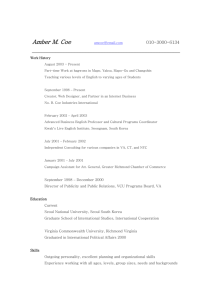
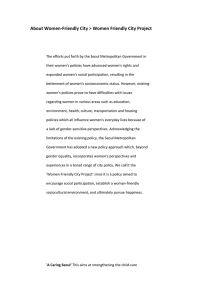

![[Slogan] Proposal for Seoul Brand Idea Contest](http://s3.studylib.net/store/data/006838769_1-d7653e11f28783f70bcf6bf0f4022941-300x300.png)
